
Worshipful Master Bart Harvey - Secretary & Editor John "Corky" Daut
The March 2011 Issue
|
|
It's Happening At Waller Lodge
By Corky
- - - - - - - - - - - - - - - -
The new District Deputy Grand Master of District #108, the Right Worshipful C. E. "Bud" Dumesnil will make his first official visit to Waller Lodge at the March stated meeting.
We will also have Brother Robert Podvin, District Instructor of District #108, grading the Lodge on opening and closing.
- - - - - - - - - - - - - - - -
The Lodge changed the date of the planed Spaghetti Supper and Silent Auction from the 19th of March to the 30th of March due to outside conflicts.
Applications for Waller Lodge’s two new $1,000.00 annual Scholarship awards, have been given to the Waller High School and will be presented to the winners at the end of the school year.
- - - - - - - - - - - - - - - - - -
The Lodge received a letter of apperception from the Eastern Star for use of the building (story in this issue)
- - - - - - - - - - - - - - - - - -
A motion was passed to invite Past Grand Master Brian Dotson to speak at a future stated meeting on ways to invest money in safe and profitable ways.
+ = + = + = + = + = + = + = + = + = +
Sickness And Distress
Please say a prayer for,
+ = + = + = + = + = + = + = + = + = +
Margaret “Memaw” Hindmarsh Haney, wife of Brother James B. Haney went to be with the Lord on February 13, 2011.
- - - - - - - - - - - - - - - -
Brother Bob Scarborough and Maxine are still staying at a assisted living facility.
- - - - - - - - - - - - - - - -
Doris Bozarth had a little trip to the hospital, but back home and doing better.

Waller Order of The Eastern Star Chapter #1047 News
(Editor’s Note; I wanted to write something about the OES Eastern Star District IV School of instructions, but I decided that Miss Diane said it best)
Waller Masonic Lodge #808
2106 Main Street
Waller, Texas 77484
January 26, 2011
Dear Masonic Brothers,
The member of Waller Chapter #1 047 Order of the Eastern Star and the Members of District IV, Section VII wish to thank you for the honor of using your Lodge Building for our Eastern Star School of Instructions held on January 24th and 25th, 2011.
We had in attendance 151.It was a little crowded but we had a good school and a good time by all. Everyone was very complementary of your Lodge. The dining hall was transform into a beautiful banquet room. I will have pictures to share with you.
Furniture was moved around in the Lodge room to accommodate our needs. I tried to put everything back where it belongs, however, if I missed something, please accept my apology.
As you probably know by now, we did have a plumbing problem in both bathrooms. However, this was quickly resolved through the efforts of Doyle Sitton and Herman Flanagan.
Again, we thank you and appreciate this honor.
Fraternally,
Diane Flanagan
Secretary, Waller Chapter # 1047
Order of the Eastern Star


Franklin, Part of Freemasons Secret Fraternity
By Seth Schroeder
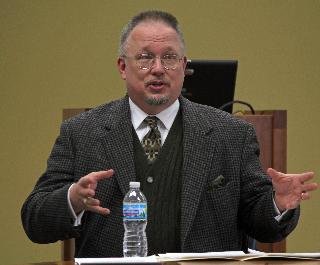 | | Michael Shirley, an instructor in the history department, talks about Benjamin Franklin's membership and activities as a Freemason on Wednesday in the Conference Room of Booth Library. (Jordan Boner | The Daily Eastern News) |
Michael Shirley, an instructor in the history department, talks about Benjamin Franklin's membership and activities as a Freemason on Wednesday in the Conference Room of Booth Library. (Jordan Boner | The Daily Eastern News)
Michael Shirley, a professor of history, tried to define the truths and rumors of Freemasonry during his seminar on Tuesday in the Booth Library Conference Room.
Shirley's presentation is part of the library's larger exhibit focusing on the life and work of Benjamin Franklin, who was a Freemason.
"Freemasonry is linked to American history because many of America's movers and shakers were Masons," Shirley said.
Shirley, who is also a Freemason at the Charleston lodge, said contrary to popular belief the Freemasons have not existed for thousands of years but were instead founded in 1717 in England. He also said that the Masons were a secret fraternity of craftsmen that often consisted of aristocrats.
Shirley explained that the Masons had secret handshakes and passwords to identify one another and that anyone who was not a member knew very little about the society. This is how rumors about the Freemasons started.
"'National Treasure' is not a documentary," Shirley said. "Some people believe it is and are trying to find clues to dig up that treasure the Freemasons supposedly hid… Do we have any pull in society? I haven't found it anymore than I've been able to find the treasure."
Shirley explained Franklin became a Master Mason in Sept. 1731 and in June 1734 he was elected the Grandmaster of Pennsylvania. Franklin printed the first Masonic book in North America and, while he was active in Freemasonry, Shirley said Franklin only mentioned it three times in his writings.
Throughout the seminar, Shirley quoted various writings by Franklin including some of his thoughts on religion. He also said it made sense for Franklin to be a Mason because the society's political and religious beliefs are similar to Franklin's. Masonic politics were similar to the "American experiment" which Franklin supported. The Masons, like Franklin, were more interested in being honorable than following exact religious principles.
Shirley said that over the 18th century, Masonry changed and became less about craftsmen and more about social mobility. Around the same time, Franklin returned from France but was less involved in the Freemasons. However, Shirley said Franklin remained a Freemason until his death.
Shirley also explained that, as a Fraternity, most Freemason lodges require members to be male. However there are women lodges and many lodges in France are co-ed. Members must also be 18 and must petition the lodge they wish to join. The lodge's preexisting members must also vote new members in.
"I didn't consider myself a joiner, but I like funny hats," Shirley said.
Seth Schroeder can be reached at scscgroeder2@eiu.edu


There are female jokes and there are unisex jokes. Here is a joke I consider a true female joke.
I offer it to you in the hopes that women will love it and men will pass it along to a woman who will love it!
A woman was sitting at a bar enjoying an after work cocktail with her girlfriends when Steven, a tall, exceptionally handsome, extremely sexy, middle-aged man entered. He was so striking that the woman could not take her eyes off him.
This seasoned yet playful heartthrob noticed her overly attentive stare and walked directly toward her. (As any man would.) Before she could offer her apologies for staring so rudely, he leaned over and whispered to her, "I'll do anything, absolutely anything, that you want me to do, no matter how kinky, for $20.00... on one condition..."
Flabbergasted but intrigued, the woman asked what the condition was. The man replied, "You have to tell me what you want me to do in just three words."
The woman considered his proposition for a moment, and then slowly removed a $20 bill from her purse, which she pressed into the man's hand along with her address. She looked deeply and passionately into his eyes, barely concealing her anticipation and excitement, and slowly and meaningfully said....
"Clean my house."
(YOU GO, GIRL!)

Saving Our History In Napperville Illinois
The Masonic Hall, at 34 W. Jefferson, may be one of downtown Naperville’s lesser-known landmarks.
“It’s not the oldest,” said Andrew Siedelmann, of the building built in 1916, “But we’re coming up on 100 years. There’s a time capsule there in the cornerstone. We’re looking to get that open and see what’s in there.”
Members of the Masonic lodge are also looking to continue their upkeep on the building. Now home
to the Naperville Running Co., the building once housed the Naper Theatre, the joists of which can still be seen in the basement. The next major project
will be tuckpointing, or replacing the nearly 100-year-old mortar holding the bricks together.
“So it’s nothing terribly exciting, but it’s to keep the mortar from wearing away,” Siedelmann said.
But their work is preserving one of the 53 architectural highlights that, according to surveyors, contribute to the “charm and character” of downtown Naperville. It was added to the downtown architectural survey released last week by the city of Naperville and the Naperville Historical Society.
The survey, conducted by Granacki Historic Consultants, documents 53 commercial buildings in downtown Naperville that tell the history of the city through architecture.
“Everyone was in agreement that the architecture, the historical ambiance, was extremely important to the vitality of the community we call downtown today as well as we thought would be important going forward,” said Peggy Frank of Naper Settlement.
The survey includes information on the architectural elements that make each building distinctive, and documents building materials, alterations and current and historical functions. Each building is classified by architectural style and documented in new and archived photographs.
The latter part of the article, with information about other buildings, has been omitted.


| Masonic Anniversaries |
| Brother | Years |
| Carl Miller | 50 |
| Marshall Peterson | 38 |
| Steve York | 36 |
| John Daut, Sr. | 21 |
| David Reynolds | 12 |
| Happy Birthday To |
| Brother | Age |
| Kenneth Healy | 95 |
| John "Corky" Daut | 83 |
| Everett F. Hoover | 74 |
| Robert F. Willie | 73 |
| Herman S. Flanagan | 68 |
| Jerry Schiel | 65 |
| Richard Ventrca | 60 |
| Eric Flanagan | 53 |
| Matt Stokes | 35 |
| Randal Dluhy | 26 |

Membership Dues, Our Sometime Neglected Duty
Chapter 18 – Title II (Grand Lodge Of Texas Law Book) “Art. 319. (354)
"Lodge dues are due and payable one year in advance on January 1st of each year (unless otherwise exempt) and if not paid on or before that date a member shall be in arrears for his dues;"
As of this date, 6 members have still not paid their 2011 dues. That means those 6 members do not have a valid dues card, are not currently members in good standing and legally can not be allowed to attend any Lodge meetings.
It appears that since members are not suspended for non-payment of dues until June 14, some members mistakenly think that is the due date.


If You Can Raed This, You Have a Sgtrane Mnid, Too.
Can you raed this? Olny 55 plepoe out of 100 can. I cdnuolt blveiee that I cluod aulaclty uesdnatnrd what Iwas rdanieg. The phaonmneal pweor of the hmuan mnid, aoccdrnig to a rscheearch at Cmabrigde Uinervtisy, it dseno't mtaetr in what oerdr the ltteres in a word are, the olny iproamtnt thing is that the frsit and last ltteer be in the rghit pclae. The rset can be a taotl mses and you can still raed it whotuit a pboerlm. This is bcuseae the huamn mnid deos not raed ervey lteter by istlef, but the word as a wlohe. Azanmig huh? Yaeh and I awlyas tghuhot slpeling was ipmorantt!
An interesting curiosity, but more seriously, something like the above happens to dyslexic readers.
The National Institute of Neurological Disorders and Stroke gives the following definition for dyslexia:
"Dyslexia is a brain-based type of learning disability that specifically impairs a person's ability to read. These individuals typically read at levels significantly lower than expected despite having normal intelligence. Although the disorder varies from person to person, common characteristics among people with dyslexia are difficulty with spelling, phonological processing (the manipulation of sounds), and/or rapid visual-verbal responding.
In adults, dyslexia usually occurs after a brain injury or in the context of dementia. It can also be inherited in some families, and recent studies have identified a number of genes that may predispose an individual to developing dyslexia."
One common misconception about dyslexia is that dyslexic readers write words backwards or move letters around when reading. In fact, this only occurs in a very small population of dyslexic readers.
Dyslexic people are better identified by writing that does not seem to match their level of intelligence from prior observations.
Additionally, dyslexic people often substitute similar-looking, but unrelated, words in place of the ones intended (what/want, say/saw, help/held, run/fun, fell/fall, to/too, etc.)
There is no cure for dyslexia, but dyslexic individuals can learn to read and write with appropriate educational support…. And that’s where the Masons are stepping in, providing dedicated classrooms and specialized teaching.
Read more about Scottish Rite Learning Centers at the Scottish Rite Learning Center of Austin.


Ben On Freemasonry
"Freemasonry has tenets peculair to itself. They serve as testmonials of character and qualifications, which are only conferred after due course of instruction and examination. These are of no small value; they speak a universal language, and act as a passport to the attentions and support of the initiated in all parts of the world. They cannot be lost as long as memory retains its power. Let the possessor of them be expatriated, shipwrecked or imprisoned, let him be stripped of everything he has got in the world, still those credentials remain, and are available for use as circumstances require. The good effects they have produced are established by the most incontestable facts of history. They have stayed the uplifted hand of the destroyer; they have softened the asperities of the tyrant; they have mitigated the horrors of captivity; they have subdued the rancor of malevolence; and broken down the barriers of political animosity and sectarian alienation. On the field of battle, in the solitudes of the uncultivated forest, or in the busy haunts of the crowded city, they have made men of the most hostile feelings, the most distant regions, and diversified conditions, rush to the aid of each other, and feel a special joy and satisfaction that they have been able to afford relief to a Brother Mason. [BENJAMIN FRANKLIN]"


|
The Small Town Texas Masons E-Magazine
Don’t miss reading the monthly Small Town Texas Masons E-Magazine at, http://www.mastermason.com/STTM-Emag/
This Month features the Phoenix Masonic Lodge #275 A.F & A.M.
and Texas Masonic History - Washington On The Brazos
|

This Month's Humor
A group of 3rd, 4th, and 5th graders, accompanied by two female teachers, went on a field trip to the local racetrack, (Churchill Downs ) to learn about thoroughbred horses and the supporting industry (Bourbon), but mostly to see the horses.
When it was time to take the children to the bathroom, it was decided that the girls would go with one teacher and the boys would go with the other.
The teacher assigned to the boys was waiting outside the men's room when one of the
boys came out and told her that none of them could reach the urinal.
Having no choice, she went inside, helped the boys with their pants, and began hoisting the little boys up one by one, holding on to their 'wee-wees' to direct the flow away from their clothes.
As she lifted one, she couldn't help but notice that he was unusually well endowed.
Trying not to show that she was staring the teacher said, 'You must be in the 5th grade.'
'No, ma'am', he replied. 'I'm riding Silver Arrow in the seventh race, but I appreciate your help.'

|
| The Waller Lodge Electronic Newsletter Subscriber's
Extra Features |
Texas Masons Provide Dental Kits For First Graders
By Jeff McKinney
SUZANNE LOUDAMY
TriCounty Leader
Whitehouse TX
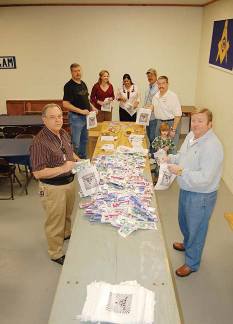 | | Masons from the Henry Marsh Bell Masonic
Lodge filled bags assembly-line style
to provide first grad students with kits
designed to prevent tooth decay. |
Masons from Henry Marsh Bell Masonic Lodge No. 1371
gathered last week to assemble nearly 350 prevent
tooth decay kits for every first grader attending Higgins
Elementary, Cain Elementary, Brown Elementary,
and Stanton-Smith Elementary, all in Whitehouse ISD.
This project, called the Fantastic Teeth Fan Club, is
made possible through a partnership with local Masons
and Masonic Children and Family Services of
Texas (MCFS).
“The goal is to help prevent children from suffering
with toothaches, reduce missed school days due to
dental problems, and cut costs for dental treatment,”
said spokesperson Rhenda Gray.
The prevent tooth decay kits contain a toothbrush,
toothpaste, dental floss, healthy teeth sticker,
twominute timer and “Tips for Healthy Teeth At Any
Age” educational flyer in both English and Spanish.
Masons from the Henry Marsh Bell Masonic Lodge
filled bags assembly-line style to provide first grad
students with kits designed to prevent tooth decay.
(Leader Staff Photo by Don Treul) According to Oral
Health In America: A Report of the Surgeon General,
tooth decay is the single most common chronic
childhood disease—five times more common
than asthma and seven times more common than hay
fever. Poor children are affected by this epidemic
more frequently than other children, with nearly
12 times more restricted activity days due to dental
issues than children from higher-income
families. A recent study from the Texas Kids Count
Project showed more than 1.5 million Texas children living in poverty—
another indicator of the great need for this type of program.
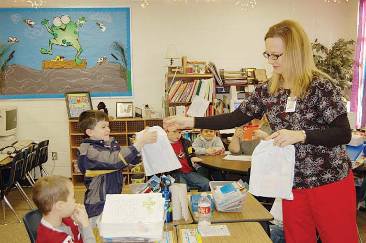 | | Jodi Bullard, the school nurse at Brown Elementary, distributed dental kits provided by the Masons |
In addition, dental problems directly affect success
for children, with more than 51 million school hours
lost each year to dental-related illness. Teachers
have judged both classroom performance and classroom
behavior to be significantly poorer among children
in need of dental care. Pain and suffering due to
untreated dental disease can also lead to problems in
eating and speaking.
Masonic Children and Family Services of Texas (MCFS)
is a non-profit organization with a history spanning
more than 100 years of providing services to the children
of Texas. Services include the Fantastic Teeth
Fan Club prevent tooth decay program, dental and
medical treatment, autism and related disorders special
classes/ therapy, educational scholarships, and
more.
To contact MCFS for services, call tollfree
(877) 203-9111, send an e-mail to info@mcfstx.org

Surviving The Big Ones
By John "Corky" Daut
The big ones for me were that 16 year period between the Great Depression and World War II. Being born in 1928, I grew up during the hard times between the stock market crash of 1929 and the end of World War II in 1945.
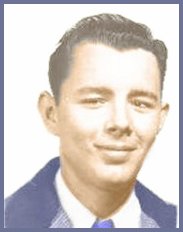 | | Corky Back Then |
I guess my first memories of going somewhere were riding in a car. One of my first memories was when mother and I went somewhere with one of her friends in and old coupe. This was probably about 1930. The friend, her daughter and mother sat in the seat and I laid up behind them, stretched out on the package shelf just under the back window of the car. I thought that was the neatest thing I'd ever did.
Regarding public transportation, my first memories were mother and I riding one of the electric street cars down Harrisburg Blvd. to downtown so mother could go to the beauty shop and get a permanent wave. I remember it because she had about a hundred wires attached to her hair. After the wave was finished we went down to the lunch counter in the basement of the Kress store and had a ham and cheese sandwich and a fountain cherry coke. I was always fascinated when eating in the Kress luncheonette because the basement actually extended out under the sidewalk to the curb line. In those days the sidewalk had a square section every couple of feet that was about 4 foot across and tiled with 4 inch squares of very thick glass. If you looked up while you were sitting at the counter, you see the soles of people's shoes through the glass as they walked down the sidewalk. Man, we were living the good life.
Even for those of us who were raised in the city, transportation was never a big problem. We always had a car, but in order to avoid trying to find a parking space when we went downtown we usually rode the streetcars until the mid 30's and then the city buses. I started going to the old Lubbock Elementary School at the corner of Harrisburg Blvd. and Samson St. in 1934 when electric streetcars were still very popular. Not only did the Harrisburg line run by the school, but it was also the main line to the car barns and just about every streetcar on the other lines leaving or returning to the barns passed by also. In the summer with the windows open, it was a very noisy place.
Dad was a druggist and we always moved when he went to work for a different drug store. We would rent a house or duplex close enough to the new job so that he could walk to work. After he went to work for the Houston Police Department however, we stayed put on Garrow Street and he rode the bus back and forth to work. There wasn't any rent houses near the police and number 1 fire station building downtown on Preston and Caroline, but the policemen and firemen could ride the buses free then by just showing their badges.
Most people rode the buses if they weren't close enough to walk to work. During the depression most couldn't afford to own a car or drive it to much if they had one. Then during WW II gasoline and tires were to scarce to waste just going to work unless you had a job vital to the war effort.
In those days you could buy a “Nickel Pass” every week from the bus company for 35 cents. With it you could ride any city bus for a nickel as often as you wanted to for one week, otherwise it cost 10 cents per ride. The bus drivers also sold “Bus Tokens” to drop in the fare box at 7 for 50 cents
The Houston Independent School District didn't furnish school buses for the students. Elementary Schools were placed close enough together for the students to walk to school. Junior High Schools and High Schools were to far apart for most students to walk and the bus company ran special buses every morning and afternoon between the schools and distant neighborhoods. Students could ride for 4 cents because you could buy a “School Bus Card”, at 20 punches for 80 cents or 40 punches for $1.60 at the school office or the bus company downtown. They were supposed to be used just to ride to and from school, but most bus drivers were pretty good guys and would let us use them on weekends or at night to ride to the movies


The Day Six Shooter Junction Earned It's Name
By Reynolds Cushman
The attempted assassination of Congresswoman Gabrielle Giffords in Tucson, Arizona and the murder of six others at the hand of a deranged 22-year-old last week is a disturbing event in which every American should be horrified. As the nation ponders what should change, if anything, regarding federal elected officials security arrangements at public meetings and gatherings, it pays to look back at a near identical event which occurred in Hempstead in 1905 under the blazing heat and passion of prohibition movements springing up across the country at the time.
In a special election to fill the unexpired term of Thomas H. Ball, a longtime Public official from Waller County, John McPherson Pinckney, was elected to the 58th Congress in 1903, and then reelected in 1904. Those who knew him in Congress called him quiet, but stern and resolute.
While the 19th Amendment, the Volstead Act, was not to be passed and ratified until 1919, many states passed their own prohibition laws much earlier and fanned the flames for a national consensus. In the climate underlying the shrill debate surrounding alcohol, Congressman Pinckney aligned himself firmly with Prohibition movement.
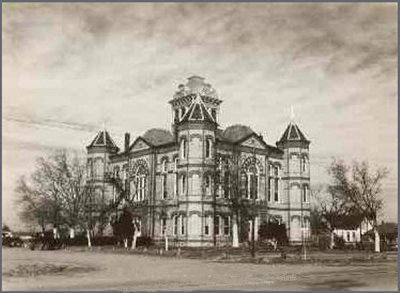 | | Waller County Courthouse In Hempstead, Circa 1900 |
The Congressman was visiting Hempstead on April 24, 19O5, intending to give support to the Prohibition League as it gathered at the Waller County courthouse to focus on a Petition seeking that the Texas Rangers enforce a newly Passed Prohibition law. Verbal sparring commenced almost immediately between the pro-alcohol and pro-prohibition camps assembled. The heckling quickly turned to mayhem.
Witnesses gave conflicting accounts of what happened next, but reportedly a fight broke out and the Congressman jumped into the fray in attempt 1o help break up the melee. Revolvers were pulled and a hail of bullets cut down the unarmed Congressman, and his younger brother, Thomas. Within two minutes some 75 bullet holes riddled the walls of the courthouse. When the shooting stopped, both Pinckney and two other men lay dead.
Congressman Pinckney was very close with his brother Thomas, and Thomas had shadowed his brother and served him in several official capacities over the decades. Thomas' loyalty ultimately, cost him his life.
One account of events that day reported that the shooter himself was among the dead, but vastly differing accounts make certainty as to what transpired impossible. Roland Brown was arrested and tried for the murder of Congressman Pinckney. In a jury trial, Brown was acquitted.
Fellow Democratic members of Congress eulogized the slain Congressman Pinckney months later from the floor of the House. Members from many states offered kind remembrances' respectful comments and recalled his arduous military service. A common theme throughout most of these eulogies was Pinckney's mild demeanor, diligent work ethic, courteous nature and upright behavior.
Pinckney was born in 1845 in Field's Store, in then Grimes County, in the waning months of the Republic of Texas. In 1861, exhibiting the courage and conviction he would display throughout his life, Pinckney enlisted in the Confederate Army at age 16, joined in the adventure by his brother Thomas' This would be the first time these brothers stepped forward together to serve Texas - an allegiance to each other that would one day Prove fatal.
Remarkably, the Pinckney brothers survived four years of deadly fighting during the Civil War with the renowned company G, 4th Texas Infantry. Civil War historians single out the 4'h Texas as likely the most celebrated of all Confederate units - a unit that Gen. Robert E. Lee would personally call on time and again in fighting from Second Manassas, Eltham's Landing, The Wilderness, Sharpsburg, Gettysburg and Chickamauga. Haggard, tired and threadbare, the 4th Texas fought until the end and was present at Lee's surrender at Appomattox in April 1865.
Pinckney exhibited leadership qualities young. He enlisted as a private but rose to the rank of lieutenant before being discharged from the defeated army at age 20.
The Pinckneys came home after the war and shortly John began studying the law. Being admitted to the bar in 1875 was a springboard for John, and he was soon Seiving as justice of the peace. He was elected district attorney in 1890, where he served until 1900 when he was elected county judge, the office he held when elected to Congress.
Congressman Pinckney was buried in the Hempstead City cemetery the services conducted by a Baptist minister with local Masonic members offering rites.
Pinckney is one of only six members of Congress to die a violent death while serving in office.
By Reynolds Cushman, & former political reporter in Austin and Washington, D.C., now lives in Hempstead.


A Little Military Humor? 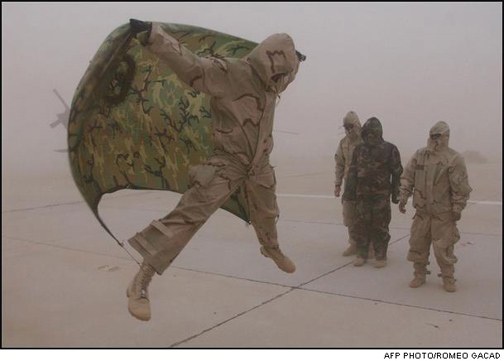
If they can just figure out how to see where they are going.

THE LION'S PAW
By H. L. Haywood
The Mackey Encyclopedia article on this subject is very brief, as may be seen from the following: "A mode of recognition so called because of the rude resemblance made by the hand and fingers to a lion's paw. It refers to the 'Lion of the tribe of Judah.'" This is true as far as it goes, but it doesn't go far enough, for it leaves unanswered the questions of origin and interpretation. Nor does the companion article on the "Lion of the Tribe of Judah" give us much more information. If Mackey refrained from saying more because he knew no more we can sympathize with him, seeing that at this late day there is still very little known about the matter. But we have learned something since Mackey wrote, enough maybe, to set us on the track toward a satisfactory understanding of the matter.
Owing to its appeal to the imagination, and to the fear and reverence it has ever aroused, the lion has often been a favorite with symbolists, especially religious symbolists. Our modern anthropologists and folk-lore experts have furnished us with numberless examples of this, even among primitive folk now living, who are sometimes found worshipping the animal. Among the early peoples of India the lion was often used, and generally with the same significance, as standing for "the divine spirit in man." Among the early Egyptians it was still more venerated, as may be learned from their monuments, their temples, and especially their sphinxes; if we may trust our authorities in the matter, the Nile dwellers used it as a symbol of the life-giving power of the sun and the sun's ability to bring about the resurrection of vegetation in the spring time. In some of the sculpture left by the Egyptians to illustrate the rites of the Egyptian Mysteries the candidate is shown lying on a couch shaped like a lion from which he is being raised from the dead level to a living perpendicular. The bas-reliefs at Denderah make this very plain, though they represent the god Osiris being raised instead of a human candidate. "Here," writes J. E. Harrison in her very interesting little book on "Ancient Art and Ritual," "the God is represented first as a mummy swathed and lying flat on his bier. Bit by bit he is seen raising himself up in a series of gymnastically impossible positions, till he rises . . . all but erect, between the outstretched wings of Isis, while before him a male figure holds the Crux Ansata, the 'cross with a handle,' the Egyptian symbol of life."
The Crux Ansata was, as Miss Harrison truly says, the symbol of life. Originally a stick, with a cross-piece at the top for a handle, it was used to measure the overflow of the Nile: but inasmuch as it was this overflow that carried fertility into Egypt, the idea of a life-giving power gradually became transferred to the instrument itself, in the same manner that we attribute to a writer's "pen" his ability to use words. A few of our Masonic expositors, among whom Albert Pike may be numbered, have seen in the Crux Ansata the first form of that Lion's Paw by which the Masonic Horus is raised. If this be the case, the Lion's Paw is a symbol of life-giving power, an interpretation which fits in very well with our own position as outlined in the two preceding sections.
But it is also possible to trace the Lion's Paw symbolism to another source. Among the Jews the lion was sometimes used as the emblem of the Tribe of Judah; as the Messiah was expected to spring from that Tribe the Lion was also made to refer to him, as may be seen in the fifth verse of the fifth chapter of the Book of Revelation, where Jesus Christ is called the "Lion of the Tribe of Judah." It was from this source, doubtless, that the Comacines, the great Cathedral Builders of the Middle Ages, who were always so loyal to the Scriptures, derived their habitual use of the lion in their sculptures. Of this, Leader Scott, the great authority on the Comacines, writes that, "My own observations have led me to the opinion that in Romanesque or Transition architecture, i.e., between A.D. 1000 and 1200, the lion is to be found between the columns and the arch-the arch resting upon it. In Italian Gothic, i.e., from A.D. 1200 to 1500, it is placed beneath the column. In either position its significance is evident. In the first, it points to Christ as the door of the church; in the second, to Christ, the pillar of faith, springing from the tribe of Judah." Since the cathedral builders were in all probability among the ancestors of Freemasons it is possible that the Lion symbolism was inherited from the Comacines.
During the cathedral building period, when symbolism was flowering out on all sides in medieval life, the lion was one of the most popular figures in the common animal mythology, as may be learned from the Physiologus, the old book in which that mythology has been preserved. According to this record, the people believed that the whelps of the lioness were born dead and that at the end of three days she would howl above them until they were awakened into life. In this the childlike people saw a symbol of Christ's resurrection after He had lain dead three days in the tomb; from this it naturally resulted that the lion came to be used as a symbol of the Resurrection, and such is the significance of the picture of a lion howling above the whelps, so often found in the old churches and cathedrals.
The early Freemasons, so the records show, read both these meanings,-Christ and Resurrection,-into the symbol as they used it. And when we consider that most of Freemasonry was Christian in belief down at least to the Grand Lodge era, it is reasonable to suppose that the Lion symbol may have been one of the vestiges of that early belief carried over into the modern system. If this be the case the Lion's Paw has the same meaning, whether we interpret it, with Pike, as an Egyptian symbol, or with Leader Scott, as a Christian emblem, since it stands for the life-giving power, a meaning that perfectly accords with its use in the Third Degree. This also brings it into harmony with our interpretation of Eternal Life for in both its Egyptian and its Christian usages it refers to a raising up to life in this world, and not to a raising in the world to come.


| Here are some of the "funnies" our grandparents enjoyed. |
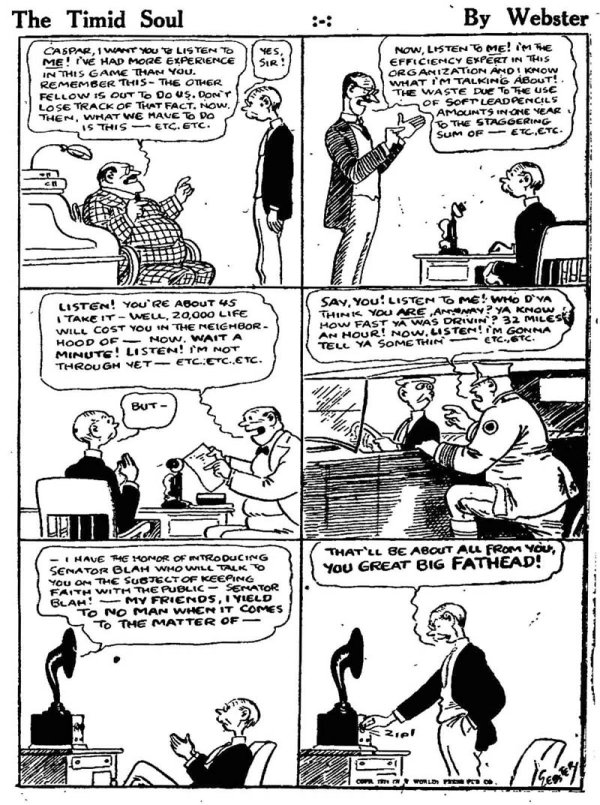

Substitutes at Funerals
From the Old Tiler's Talk - by Carl H. Claudy, The Temple Publishers
"It's too bad!" complained the New Brother, "I've got drawn on a funeral committee on the very day I want to play golf. I wonder if I can find a substitute?"
"Very likely," answered the Old Tiler. "The world is full of substitutes who perform the duties of people too lazy, inefficient, and careless of the rights of others to do it themselves."
"Oh, come now, don't be so rough!" The New Brother winced. "Going to funerals is all form. Why, I never even saw this deceased brother! What difference will it make to him or his family if I go to his funeral myself or get someone else to go for me?"
"No difference at all," agreed the Old Tiler. The only person to whom it will make any difference will be you."
"The difference it will make to me will be the difference between being bored and having a good game of golf!" asserted the New Brother.
"It will make other difference." The Old Tiler was very emphatic. "One of them is that the only importance Masonry has is what it does to a man's heart. Objectively, it is of less importance than the necktie he wears. The important part of Masonry is its leavening power on that part of a man which is the ego, the person, the individual.
"The effect Masonry has on a man's heart is aided by the mechanics of Masonry; temple, lodge room, dignity of the order, its public appearances, the respect it shows to its dead, its educational work, appeal to the general public, its secrecy, its reputation of being above party and politics, its alliance with all religion and its participation in none. These make Masonry objective, but they are the outward semblance of the inward and spiritual Masonry. These you ought to know for yourself: charity, relief, brotherly love, truth, knowledge, self-sacrifice, tolerance.
"But how can you separate the inward and spiritual from the outward and objective? We build beautiful temples and meet in handsome lodge rooms, to express our love for our belief. We make lodge work dignified, well done, impressive, to express to ourselves our sense of the dignity of the truths we teach. We conduct the funeral of a deceased brother, not to make a show before the world, but to express to ourselves our regret that a brother has departed and our conviction that he has but traveled upward to that Temple Not Made With Hands, where the Supreme Architect waits for all who have been builders upon earth.
"The world does judge by externals. As we make an impressive appearance at a funeral, so do the profane judge us. If we make a poor and straggling appearance at a funeral, we are judged by those who do not know Masonry from the inside. Therefore it is important to those who care for the good name of Masonry that our funerals are well attended and that we conform to these outward marks of grief which custom has made essential at a funeral.
"It is usual to have a funeral committee. In large lodges it is more essential than in small, because in small lodges everyone knows everyone else and goes to a funeral because he wants to. In large lodges we don't know everyone, and unless we have a committee we don't put up the right kind of 'front' at a funeral. The more obscure and unknown the brother, the less the size of the lodge turnout. Hence the committee, chosen by lot or alphabetical order.
"In this lodge we have many members and we chose fifty brethren by the alphabet. Once in twenty funerals your name will be drawn. If we have five funerals a year, which is average, you will be called upon once in four years to aid your lodge to show its respect for the grief of the family of a departed brother, and show the profane that Masonry honors its own.
"You can get a substitute. I will substitute for you if you wish. I have no golf game to attract me. I substitute for a many good men. Sometimes I substitute because of a real reason; business, absence, illness. Sometimes I substitute because a man is too careless and too lazy to do his own work. But then, nothing I can do will help him. For the sake of the lodge I go in his place. For his own sake I try to show him what a mistake he makes in delegating to another the duty he owes his fraternity.
"Masonry means something in my heart. It means more as its reputation grows. If anything I can do aids that reputation, I am glad. When is this funeral you want me to attend for you?
"I don't want you to," answered the New Brother. "I've got to go now..."
"What's your hurry?" asked the Old Tiler.
"I want to see the Secretary and tell him to put me down as a possible substitute next time, when someone does what I was going to do- miss my chance to do my last duty to one of my brethren."


Back To Index Page
No © Copyright. Free To Use.
|
|

